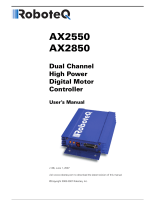
5
T
U
S
R
REL
T1
T2
T1
Regulowane opóźnienie zadziałania z
regulowanym czasem załączenia REL
T
U
S
R
T1 T2
T1+Ts
Ts
T2
T2
Praca cykliczna z regulacją czasów
wyłączenia T1 i załączenia T2
4. Parameters programming.
1. Install PROGRAM jumper, PROG diode will confirm the input with 10 short flashes.
2. A selection of relay’s program: select required program from 1-8 through switchover to ON position of TIME/MODE
DIPSWITCH. PROG diode will start signalling the number of selected program using flashes.
3. Press SET/RESET button, the diode will confirm selected program by fast flashes. Depending on selected program a
module switches over to T1, T2 time configuration or programming will be finished (for 2,3 mode).
4. Setting of T1/T2 actuation time:
a) hh diode flashes, entering hours decimals, PROG signals selected value
b) press SET/RESET
c) h diode lights, entering hours units, PROG diode signals selected value
d) press SET/RESET
e) mm diode lights, entering minutes decimals, PROG diode signals selected value
f) press SET/RESET
g) m diode lights, entering minutes units, PROG diode signals selected value
h) Press SET/RESET
i) ss diode lights, entering seconds decimals, PROG diode signals selected value
j) Press SET/RESET
k) S diode lights, entering seconds units, PROG diode signals selected value
5. Setting of T2 actuation time, a procedure similar to the one in point 4.
6. Programming completion, 10 short flashes of PROG diode.
7. Remove PROG armature.
Actuation with regulated time of REL
activation S starts T1 timing after S giving.
When the time expires and S is still active than
REL actuates on T2 period, R giving causes
REL deletion and activates awaiting on
repeated S giving.
8. Cycling with time control of T1 trip
out and T2 actuation
REL relay actuates on T1 period after
supply feeding, consequently T2 break timing
starts, after that T1 actuation takes place,
break timing/actuation can be locked by S
signal (level control), R signal giving deletes
REL and starts timing from the beginning).
Adjustable Time-lag trip with
regulated REL activation time
Cycling with time control of T1
trip-out and T2 actuation








